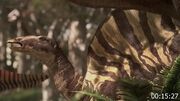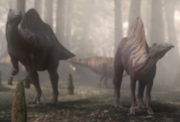| Ouranosaurus | |
|---|---|

| |
| A restoration of Ouranosaurus nigeriensis | |
| Scientific classification | |
| Kingdom: | Animalia |
| Phylum: | Chordata |
| clade: | Dinosauria |
| Order: | †Ornithischia |
| Suborder: | †Ornithopoda |
| Genus: | †Ouranosaurus Taquet, 1976 |
| Species: | †O. nigeriensis |
| Binomial name | |
| †Ouranosaurus nigeriensis Taquet, 1976 | |
Ouranosaurus, meaning (Brave Monitor Lizard), was an unusual Ornithopod that lived during the Late Cretaceous (Late Aptian Stage) about 110 million years ago in what is now Africa. Ouranosaurus measured about 7 meters (23 feet) in length and weighed about 4 tons. Two complete fossils were found in the Echkar (or El Rhaz) Formation, Gadoufaouna deposits, Agadez, Niger in 1966 and the animal was named by a French paleontologist in 1976 called Phillipe Taquet.
The Ouranosaurus was named "brave" due to the fact that the nomadic people of the Sahara call a native species of monitor lizard, "ourane" which means brave. The resemblance was carried on.

Description
Ouranosaurus had a large sail over 2 feet (63 centimeters) in height on its back, supported by thick, long spines that spanned its entire back and part of its tail, like Spinosaurus, a well known meat-eating dinosaur that lived at roughly the same time and place, and the older Dimetrodon of the Permian Period. There is no certain answer as to why Ouranosaurus had the sail, but it could've been used to control heat or attract mates and scare off rivals. The sail is a unique feature that is found on only a few dinosaurs and no living animals, obviously with an exception of Ouranosaurus.
Ouranosaurus was a quadruped dinosaur, and it is thought like other Iguanodontids, Ouranosaurus walked primarily on all fours. However, it also might've ran on its hind legs to escape predators such as Carcharodontosaurus.

Ouranosaurus Skeleton
Because of the thumb spike on its front legs it was initially thought to be closely related to Iguanodon, and was actually identified as an iguanodontid, but more recent studies show it to be a sister-species both to Iguanodon and the first true hadrosaurs instead.
Ouranosaurus likely lived in a river delta, a collection of marshes and swamps alongside the other sail-backed dinosaur, Spinosaurus. ts skull was rather flat, and was a little over 2 feet long, but it was filled with hundreds of teeth, perfectly designed for chewing tough plants like cycads. It was the main prey item of very large predators like the Carcharodontosaurus, the crocodilian Sarcosuchus, and the also-sailed Spinosaurus, although it may have defended itself with the thumb spikes and flushing blood into its sail. It wasn't exactly easy prey either.
In the Media
Ouranosaurus was featured in a documentary about Sarcosuchus, one of its predators, called Super Croc, and was shown to have been killed and eaten by one of these large killers.
It was also featured in the documentary Planet Dinosaur, where a herd of them was attacked by a Carcharodontosaurus and one of them was killed and eaten by the predator soon afterward. However, in a later episode, the same herd was seen again, browsing, while a herd of Paralititan went past.
It also appears in Jurassic Park: Operation Genesis as a dinosaur the player is able to place in their park.
Ouranosaurus also appears in Jurassic Park Builder as a gold herbivore. It, however, vaguely resembles the real creature. It lacks its thumb claw, the sail is too small, and its hadrosaur-like beak is missing.
Ouranosaurus appeared in the video game Jurassic World: Alive, as an Epic creature, and spawns often in Bank areas, the game requires you to dart 150 Ouranosaurus DNA to unlock it.
Ouranosaurus appeared in the video game Jurassic World: Evolution’s Claire’s Sanctuary DLC, as one of the new dinosaurs.


Planet Dinosaur Ouranosaurus
Ouranosaurus/Gallery